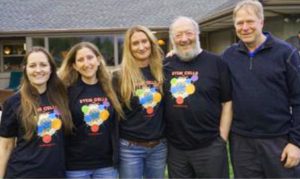
NIAID News Service
NIAID immunologist Kim Hasenkrug says there’s more to being a productive scientist than being smart and having vast knowledge. “People don’t understand that a lot of creativity is needed to do great science,” he says.
Hasenkrug’s research colleague, Irving Weissman of Stanford University, understands. For 27 consecutive years Weissman has used his Montana ranch and NIAID’s nearby Rocky Mountain Laboratories (RML) as an ideal setting to foster collaborations between Stanford research groups and NIAID scientists.
The “Weissman Retreat” is a multi-day gathering where budding, mid-career and senior scientists share ideas and plan projects, sometimes while fishing on the Bitterroot River adjacent to Weissman’s ranch, sometimes while hiking the miles of nearby canyon trails, or sometimes during casual discussions at the laboratory campus or the ranch dinner table.
Prior to starting the retreat, Weissman, who has been at Stanford since 1960, noticed that his lab group “wasn’t working together well enough. And they had no idea what Montana was like. So, I decided to bring them out” to try and spark their creativity.
The setting makes a huge difference: “They hike together, they fish together … they talk all the afternoon, they plan experiments,” Weissman says. During the 2019 retreat at the end of August, 35 scientists representing 10 research groups discussed projects ranging from cancer therapies to brain regeneration. Hasenkrug, a senior investigator at RML, adds, “We sit down, eat, drink – and talk science for hours. Some of those conversations have led to important experiments.” Hasenkrug said he has initiated four new translational research projects since the latest retreat ended.
The seed for the retreat was planted in the mid-1980s during a meeting held at a guest ranch on the Sun River at the eastern edge of the Bob Marshall Wilderness in Montana. At the time, Hasenkrug worked for what now is the McLaughlin Research Institute for Biomedical Sciences in nearby Great Falls. Weissman had also worked there; both were raised in Great Falls, Montana. Weissman recalls Harold Varmus, a future Nobel laureate and National Institutes of Health director, and David Baltimore, also a Nobel laureate, being present at the Sun River meeting. Weissman felt that the relaxed outdoor setting fostered creativity and openness, and a decade later when Weissman and some of his research friends bought a ranch south of Hamilton, Montana – about a 15-minute drive from RML – he decided to try to rekindle that atmosphere with scientists at RML.
Weissman knew of RML’s excellence from his interest in science in high school, and in the late 1980s he was invited to speak to RML staff about his research at Stanford.
Weissman quickly realized the value his Stanford students would have by interacting with RML scientists and using the ranch as a home base. Part of Weissman’s research has focused on how the immune system develops and functions, and he saw that his work meshed well with RML scientists who specialize in infectious disease research – he knew the two fields could greatly benefit through collaboration.
NIH and NIAID leaders agreed to provide Weissman’s group access to RML, and in 1992, with the help of RML scientist Gerald Spangrude, the first retreat was held. Spangrude, a Montana native who had worked for Weissman at Stanford, left RML in 1994, and Hasenkrug – then an RML post-doctoral fellow – took over hosting the retreats. Since its start, Weissman has invited about 50 Stanford guests each year, at his expense, to stay at his ranch and meet with scientists from RML. Hasenkrug and his group coordinate the planning and participation by RML staff.
Since the retreat began, collaborations between NIAID and the Weissman group have led to development of a new mouse model to study HIV that resulted in six peer-reviewed publications, as well as three published studies using the mice to study Ebola virus. Together, the Weissman and Hasenkrug labs now are investigating possible new therapeutics for infectious diseases based on CD47, an immune system protein that the Weissman group pioneered for cancer therapeutics that are in phase 1b and phase 2 clinical trials.
Smiling over coffee at his dining table as the latest retreat wound down, recalling the people and projects the retreat has influenced, and his continued appreciation for NIH and NIAID support, Weissman simply said, “It worked out.
“… it’s a good example of scientific collaboration and cooperation. We all have a will to talk to each other and over the years to develop relationships.”
